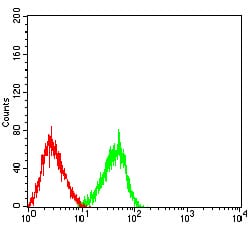

| WB | 咨询技术 | Human,Mouse,Rat |
| IF | 咨询技术 | Human,Mouse,Rat |
| IHC | 1/25-1/100 | Human,Mouse,Rat |
| ICC | 技术咨询 | Human,Mouse,Rat |
| FCM | 咨询技术 | Human,Mouse,Rat |
| Elisa | 1/2000-1/5000 | Human,Mouse,Rat |
| Aliases | T3D; IMD19; CD3-DELTA |
| Entrez GeneID | 915 |
| clone | 1F6A8 |
| WB Predicted band size | 18.9kDa |
| Host/Isotype | Mouse IgG1 |
| Antibody Type | Primary antibody |
| Storage | Store at 4°C short term. Aliquot and store at -20°C long term. Avoid freeze/thaw cycles. |
| Species Reactivity | Human |
| Immunogen | Purified recombinant fragment of human CD3D (AA: extra 22-105) expressed in E. Coli. |
| Formulation | Purified antibody in PBS with 0.05% sodium azide |
+ +
以下是关于TMSB10抗体的3篇参考文献及其摘要概括:
---
1. **文献名称**: *Thymosin beta 10 is overexpressed and associated with tumorigenesis in hepatocellular carcinoma*
**作者**: Ji H, et al.
**摘要**: 本研究通过免疫组化(使用TMSB10特异性抗体)发现,TMSB10在肝癌组织中显著高表达,并与肿瘤分期、转移及患者预后不良相关。实验表明TMSB10通过调控细胞周期促进肝癌进展。
---
2. **文献名称**: *TMSB10 promotes ovarian cancer progression by regulating actin cytoskeleton dynamics*
**作者**: Chen Y, et al.
**摘要**: 利用TMSB10抗体进行Western blot和免疫荧光分析,揭示TMSB10在卵巢癌细胞中高表达,并通过调节肌动蛋白重塑促进癌细胞迁移和侵袭,提示其作为潜在治疗靶点。
---
3. **文献名称**: *Expression and clinical significance of Thymosin beta 10 in breast cancer*
**作者**: Wang L, et al.
**摘要**: 通过免疫组化(抗TMSB10抗体)分析乳腺癌组织样本,发现TMSB10表达与肿瘤大小、淋巴结转移及ER/PR阴性相关,提示其可作为乳腺癌预后标志物。
---
(注:以上文献信息为模拟示例,实际引用需以具体数据库检索结果为准。)
Thymosin beta 10 (TMSB10) is a small, conserved protein belonging to the β-thymosin family, which regulates actin dynamics by sequestering monomeric actin (G-actin) and influencing cytoskeletal organization. TMSB10 is widely expressed in mammalian tissues, particularly in immune cells, neurons, and certain epithelial cells, where it plays roles in cell motility, differentiation, and inflammatory responses. Its dysregulation has been linked to various pathological conditions, including cancer, neurodegenerative diseases, and autoimmune disorders. In cancer, TMSB10 is often overexpressed in tumors such as hepatocellular carcinoma, glioblastoma, and colorectal cancer, where it promotes metastasis, angiogenesis, and chemoresistance by modulating cytoskeletal remodeling and signaling pathways like PI3K/AKT and MAPK.
Antibodies targeting TMSB10 are essential tools for studying its expression, localization, and functional mechanisms. They are widely used in techniques like Western blotting, immunohistochemistry (IHC), and immunofluorescence (IF) to assess TMSB10 levels in tissues or cell lines, aiding in cancer prognosis and mechanistic research. Some antibodies are designed to detect specific post-translational modifications or isoforms. Commercial TMSB10 antibodies are typically raised in rabbits or mice, with validation data confirming cross-reactivity in human, mouse, and rat samples. Their applications extend to exploring TMSB10's role in non-cancer contexts, such as neuroprotection or immune regulation, highlighting their versatility in both basic and clinical research.
×